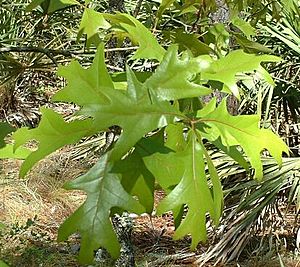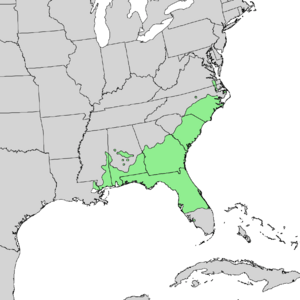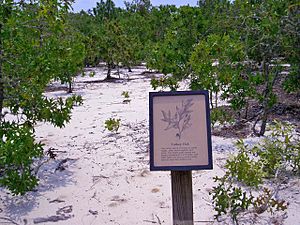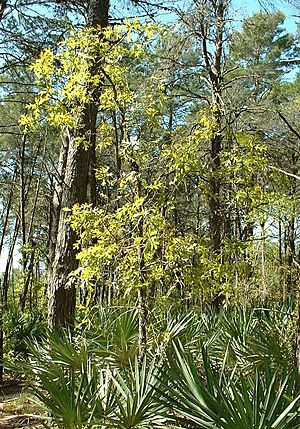Turkey oak facts for kids
Quick facts for kids Turkey oak |
|
|---|---|
 |
|
| American turkey oak foliage | |
| Conservation status | |
| Scientific classification | |
| Genus: |
Quercus
|
| Species: |
laevis
|
 |
|
| Quercus laevis native range | |
| Synonyms | |
|
|
The Turkey Oak (scientific name: Quercus laevis) is a type of oak tree. It belongs to the group known as red oaks. These trees are found naturally in the southeastern United States. You can see them along the coast from Virginia down to central Florida. They also grow west into southeast Louisiana. In some places, they even grow near tropical trees like coconut palms.
The name "turkey oak" comes from its leaves. They look a bit like a turkey's foot! There's another tree in Turkey and southern Europe called Quercus cerris that is also known as Turkey oak. To tell them apart, Quercus laevis is sometimes called the American Turkey Oak.
What Does a Turkey Oak Look Like?
The Turkey Oak is usually a small tree. Sometimes, it can even look like a shrub. Most Turkey Oaks grow to be about 8 to 10 meters (26 to 33 feet) tall. However, some can grow much taller, up to 28 meters (92 feet).
Its leaves can be different sizes. They are usually 10 to 17 centimeters (4 to 7 inches) long. Each leaf has 3 to 7 thin, deep cuts called "lobes." At the tip of each lobe, there are 1 to 3 tiny, stiff points called "bristle teeth." In the fall, these leaves turn a beautiful red color.
The acorns of the Turkey Oak are about 20 to 25 millimeters (0.8 to 1 inch) long. Like other red oaks, their acorns take a long time to grow. They need about 18 months to fully mature.
Where Do Turkey Oaks Grow?

Turkey Oaks are tough trees. They often grow in places where other trees struggle. This includes poor, thin, dry, or sandy soils. You might find them on rocky ground too. One of the few other oaks that can grow in these tough spots is the Blackjack oak (Q. marilandica).
Even though it might not have the perfect shape of some other oaks, the Turkey Oak is very important. It helps to grow on dry, sandy land that isn't very fertile. Its deeply cut leaves also look very interesting. You often see Turkey Oaks growing under longleaf pine trees. They like sandy hills in the southeastern United States.
Images for kids





